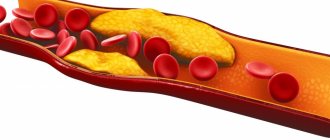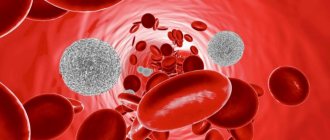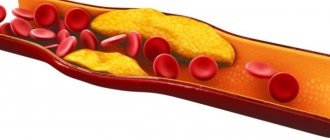Detailed description of the study
Triglycerides are simple fats (lipids) that provide energy to cells during fasting or intense physical activity. An increase in their level in the blood is one of the reasons for the development of diseases of the cardiovascular system, liver, and pancreas.
Triglycerides come from foods or are formed in the liver and fat cells. Those that come with food are absorbed in the small intestine and, as part of large transport molecules (chylomicrons), are transported through the lymphatic vessels into the plasma.
Triglycerides are used by muscles and other tissues as an energy substrate. Some is stored in adipose tissue, the other is in the plasma, mainly in combination with proteins - a complex called very low-density lipoproteins (VLDL) is formed. The amount of triglycerides changes throughout the day. It rises in the blood half an hour to an hour after eating due to the formation of chylomicrons.
With excess nutrition, there is an increased formation of fatty acids by fat cells, and they accumulate in the liver. This leads to increased formation of triglycerides, which are released into the blood as part of VLDL.
Errors in nutrition are the main cause of lipid metabolism disorders. Excessive consumption of saturated and trans fats (butter, fatty meats, confectionery), alcohol, and simple sugars increase the content of triglycerides in the blood.
Determining the amount of triglycerides helps to identify primary and secondary disorders of lipid metabolism (hypertriglycemia). Such conditions increase the risk of diseases of the heart and blood vessels, as well as the liver and pancreas, so timely diagnosis helps to take preventative measures.
Primary hypertriglyceridemias are hereditary diseases. They are very rare and are associated with a genetically determined disruption of the enzymes that are involved in lipid metabolism. This leads to the accumulation of chylomicrons in the blood.
Secondary ones arise against the background of other diseases - diabetes mellitus, disorders of the thyroid gland, kidneys. Due to an imbalance of lipids, fatty plaques begin to be deposited in the walls of blood vessels, and atherosclerosis develops. Atherosclerotic plaques cause narrowing and blockage of blood vessels, which leads to thrombosis, strokes, and heart attacks. In the liver and pancreas, against the background of hypertriglyceridemia, fat deposits are detected, which can impair the function of the organ and lead to the development of hepatitis and pancreatitis.
Factors such as lack of exercise, excess weight, smoking, and excessive alcohol consumption can contribute to an increase in the amount of triglycerides in the blood plasma.
Measuring triglyceride levels is an important test in the diagnosis of pathology of the heart and blood vessels, liver and pancreas. Timely detection of triglyceride metabolism disorders along with other indicators of lipid metabolism helps prevent many diseases.
Triglycerides (TG)
Other names: Blood lipids, neutral fats, TG, Triglycerides, Trig, TG.
Service code 1072
general information
Triglycerides (TG) are complex fats that enter the body with fatty plant and animal foods and can also be synthesized in the liver. The level of triglycerides in the blood is constantly changing: the highest amount is observed after eating, then it gradually decreases and returns to normal when all the triglycerides are distributed throughout the cells of the body.
TG are deposited in the cells of subcutaneous fat “in reserve”, where they perform a thermal protective function, retaining the heat generated in the body, and also protect internal organs from possible mechanical damage. Triglycerides are the most important source of energy for muscles, since 1 g of fat, when broken down, provides twice as much energy as the same amount of protein or carbohydrate.
When triglyceride metabolism is disrupted, excess fat deposition most often occurs in the subcutaneous tissue and around internal organs—obesity. Increasing triglyceride levels in the body increases the risk of developing cardiovascular diseases and acute pancreatitis.
A blood test for triglycerides in combination with cholesterol is used to assess the risk of developing atherosclerosis and cardiovascular diseases, as well as to diagnose hereditary disorders of lipid metabolism.
Important! Triglyceride levels can be significantly elevated (5-10 times) even several hours after eating. Blood values taken on an empty stomach at different times may also be different. Some people experience a 40% change in triglyceride levels within a month. This phenomenon is called biological variation and reflects normal fluctuations in cholesterol metabolism in the body. Thus, a single test does not always reflect “usual” triglyceride levels, so sometimes a retest is required.
A triglyceride test should be taken outside the acute phase of the disease, and after a heart attack or surgery - at least 6 weeks later.
Indications for the purpose of analysis:
- scheduled preventive examination;
- assessing the risk of developing atherosclerosis, heart and vascular problems;
- monitoring the effectiveness of a diet with a reduced amount of animal fats and monitoring blood lipid levels after prescribing drugs that reduce triglycerides and cholesterol;
- diabetes;
- myocardial infarction;
- pancreatitis;
- hereditary disorders of lipid metabolism;
- gout;
- the presence of one or more risk factors for the development of cardiovascular diseases: smoking;
- age (men over 45 years old, women over 55 years old);
- high blood pressure (140/90 mmHg and above);
- coronary heart disease, heart attack or stroke;
- excess body weight;
- alcohol abuse;
- eating large amounts of food containing animal fats;
- low physical activity;
- high cholesterol or cardiovascular disease in other family members (heart attack or stroke in an immediate male relative under 55 years of age or a female relative under 65 years of age).
Research method: homogeneous enzymatic colorimetric method
Analyzer : Cobas 6000
Units: mmol/l
Material for research: venous blood serum
Recommendations for preparing for analysis:
- take on an empty stomach, after sleep;
- stop eating 8-12 hours before the test;
- You can only drink clean, still water;
- do not smoke for 2 hours before the test;
- do not consume spicy, fatty, fried foods and alcohol for 2 days;
- exclude physical and emotional stress 1 day before the analysis;
- do not take the test after radiography, physiotherapeutic procedures and instrumental studies.
Interpretation of analysis results:
The result of laboratory tests is not a sufficient basis for making a diagnosis. Interpretation of the results and diagnosis is carried out only by the attending physician.
Reference values: up to 2.26
Conversion factor : mmol/l x 88.5 = mg/dl
Possible causes of increased TG levels (hypertriglyceridemia)
Primary hyperlipidemias:
- familial hypertriglyceridemia (phenotype IV);
- complex familial hyperlipidemia (phenotype II b;
- simple hypertriglyceridemia (phenotype IV);
- familial dysbetalipoproteinemia (phenotype III);
- chylomicronemia syndrome (phenotype I or V);
- LCAT (lecithin-cholesterol acyltransferase) deficiency;
- Gierke's syndrome.
Secondary hyperlipidemias:
- coronary heart disease, myocardial infarction, atherosclerosis;
- hypertonic disease;
- obesity;
- viral hepatitis and liver cirrhosis (alcoholic, biliary), obstruction of the biliary tract;
- diabetes;
- hypothyroidism;
- nephrotic syndrome;
- acute and chronic pancreatitis;
- taking oral contraceptives, beta blockers, thiazide diuretics;
- pregnancy;
- glycogenosis;
- Thalassemia.
Possible causes of decreased TG levels (hypotriglyceridemia):
- abetalipoproteinemia;
- COPD (chronic obstructive pulmonary disease);
- physical activity (transient decrease);
- malnutrition;
- loss (permanent decrease) of weight;
- hypolipoproteinemia;
- hyperthyroidism;
- hyperparathyroidism;
- malabsorption syndrome;
- intestinal lymphangiectasia.
Substances and drugs that affect the increase in TG levels: beta blockers, catecholamines, corticosteroids, cyclosporine, diazepam, diuretics, estrogens, ethanol, interferon, retinol, miconazole.
Substances and drugs that affect the reduction of TG levels: ascorbic acid, aminosalicylic acid, asparaginase, clofibrate, heparin, fish oil, prazosin.
Where to get tested for triglycerides (TG)
You can take a triglyceride (TG) test at any Synevo point in Minsk, Gomel, Brest, Grodno, Vitebsk, Mogilev, Bobruisk, Baranovichi, Soligorsk, Slutsk, Polotsk, Novopolotsk, Orsha, Zhlobin, Svetlogorsk, Molodechno, Mozyr, Pinsk, Borisov, Rechitsa, Smorgon.
References
- Diagnosis and correction of lipid metabolism disorders for the prevention and treatment of atherosclerosis. Eurasian Association of Cardiologists National Society for the Study of Atherosclerosis (NOA), 2020. - 61 p.
- Alves-Bezerra, M., Cohen, D. Triglyceride metabolism in the liver, 2021. - Vol. 8(1). — P. 1-8.
- ESC/EOA recommendations for the diagnosis and treatment of dyslipidemia, 2016. - 71 p.
- Ershova, A.I., Ivanova, A.A., Aksenova Yu.O. and others. Secondary hyperlipidemia: etiology and pathogenesis, 2021. - 113 p.
How to prepare for the procedure?
- Blood sampling for biochemistry is always performed on an empty stomach, most often between 8 and 11 am. On the day of the procedure, it is allowed to drink still water, and the day before the procedure, heavy foods, carbonated drinks, strong coffee, tea and alcohol should be excluded from the diet.
- You should not smoke in the last hour before donating blood.
- Immediately before the procedure, try to avoid physical and emotional stress; for the last 10–20 minutes it is better to just sit near the manipulation room.
- If the date of the biochemical blood test falls during a course of drug treatment or a course of physical therapy, then it is worth consulting with a doctor - he may recommend rescheduling the test to another time or interrupting the course of treatment for several days.
How can you lower your triglyceride levels?
If a high level of TG is detected in the blood, dietary adjustments will help return it to normal levels. Using a certain diet will help eliminate some other metabolic disorders. First of all, this is sea fish, as well as all kinds of seafood. A large-scale study was carried out with an experimental and control group, it made it possible to establish that if you eat at least 200 g of fish per day, this will reduce the TG content in the blood.
The experiments weren't limited to fish: the study also looked at the inclusion of oysters, clams or crustaceans in the diet. They also turned out to be quite effective in the fight to lower TG levels. Their diet will have to exclude several food groups:
- Pastries, cakes, etc., as well as refined sugar. They negatively affect metabolism; overeating can cause obesity and diabetes.
- Alcoholic drinks. Alcohol has a destructive effect on various organs and systems: it can cause damage to the liver and kidneys, and has a bad effect on the condition of blood vessels and the functioning of the heart.
- Fatty meat foods: lard, brisket, bacon, etc. Overeating will cause obesity, in addition, such foods provide very little benefit to the body.
- In addition to diet, your doctor may prescribe several types of medications.
What should be the normal triglyceride level?
Triglycerides in the blood
The unit of measurement of TG in the blood is mol/liter; the parameter depends on the age characteristics and gender of the patient. The normal amount in the blood is determined within the following limits:
- 0-15 years. For women, the norm is 0.4-1.48, for men - 0.34-1.15.
- 15-25. Women - 0.4-1.53, male 0.45-2.27.
- 25-35. Women - 0.44-1.7, male 0.52-3.02.
- 35-45. Women - 0.45-2.16, male. 0.61-3.62.
- 45-55. Women - 0.52-2.63, male. 0.65-3.71.
- 55-65. Women - 0.62-2.96, male. 0.65-3.29.
- 65-75. Women - 0.63-2.71, male. 0.62-3.29.
It is believed that the maximum value that TGs reach in women in adulthood is 1.5 mmol/l. This usually indicates that menopause will soon occur.
What does a decrease in triglycerides mean?
TG levels increase with poor diet
The level of triglycerides begins to decrease with malnutrition, in addition, it can signal a number of pathological processes: obstructive pulmonary diseases, deep lesions of liver tissue, hyperthyroidism, etc. This indicator can also indicate malabsorption syndrome, lactosuria and some other pathological conditions . Thus, a blood test for triglycerides greatly simplifies the diagnosis. A change in indicators that deviates from the norm is evidence that organs and tissues are not working correctly, and metabolic processes need to be adjusted.








